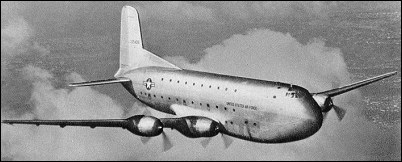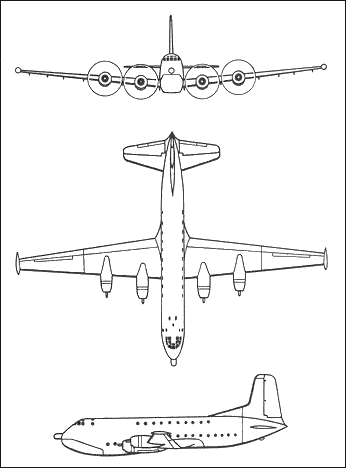 |
Douglas C-124 Globemaster II1949 |  |
| TRANSPORT | Virtual Aircraft Museum / USA / Douglas |
 |
Despite having been the world's largest landplane transport when it flew in 1945, the Douglas C-74 Globemaster was actually too small-in volume-to accommodate the outsized loads dictated by the American military's postwar logistical needs. In response to this problem, the fifth C-74 was held back at the factory to undergo far- reaching modifications under the new designation YC-124. Using the wings, engine nacelles, and tail group of the C-74, Douglas evolved an entirely new fuselage by adding five feet ten inches to overall length, raising the height of the main cargo bay five feet, and lowering the depth of forward fuselage to permit loading of trucks, artillery pieces, aircraft sub- assemblies, or bulky equipment through a set of full- width clamshell doors in a new nose section that incorporated a built- in, hydraulically lowered ramp. The aft, belly loading hatch of the C-74 was retained, and to assist fore and aft movement of large loads, two overhead hoists, with 16,000 lbs. lifting capacity each, were installed in the main cargo bay. When rigged in a double deck configuration, the new fuselage design could also house 200 fully equipped troops or 127 evacuees in medical litters. Dubbed "Globemaster II," the YC-124 completed its maiden flight on November 27, 1949, and deliveries of the first of 204 C-124A production models to the USAF commenced in May 1950. The prototype became the YC-124A when re- powered with 3,800-hp R-4360-35A engines, then reemerged in 1954 as the YC-124B after being modified to serve as a flying testbed for 5,500-shp Pratt & Whitney YT34 turboprop engines. A KC-124B tanker variant was considered as a potential KC-97 replacement but never materialized. The Long Beach plant shifted to production of 243 improved C-124Cs delivered between 1952 and 1955, which differed in having 3,800-hp R-4360-63A engines, an APS-42 weather radar in a nose- mounted thimble radome, and wingtip- mounted combustion heaters that provided thermal de-icing and cabin heating, and over a period of years, the existing C-124A fleet received retrofits that brought them up to the C standard. A pressurized variant was studied as the C-124X but never built, and during the mid-1950s, a much redesigned turboprop- powered, swept- wing derivative, designated XC-132, got as far as the mockup stage but was ultimately canceled in favor of the C-133. C-124As began entering service during 1950 in time to play an important role in the Korean War (1950-1953). For the first time, MATS possessed a long- range aircraft capable of loading bulky items like tanks, guns, trucks, and construction equipment without major disassembly; and in Strategic Support Squadrons, new Globemasters gave SAC the ability to deliver large aircraft components to any of its widespread bases. As the USAF's C-124A and C fleet grew to planned strength in the mid-1950s, it formed the bulk- carrying nucleus of every major U.S. military airlift operation conducted from that time up until the late 1960s. Some of the C-124's more notable achievements included moving an entire squadron of Lockheed F-104s from the U.S. to Taiwan during the Formosa Straits Crisis in 1958; during Operation Deep Freeze (1957-1962), regular airdrops from C-124s formed the supply line from McMurdo Base to outlying stations in the Antarctic; and as part of Operation Big Lift in 1963, MATS C-124s moved the 2nd Armored Division and a TAC Strike Force from U.S. bases to Germany in two and a half days. At their peak in 1963, 377 C-124s were operating with 20 different transport squadrons. As American involvement in Southeast Asia escalated in the mid-1960s, C-124s began flying transport sorties directly into South Vietnam, and from early 1966, continued with Military Airlift Command (MAC) when that organization replaced MATS. Although the USAF started the process of phasing- out C-124s from frontline service and transferring them to reserve and ANG units in mid-1960s, the type's bulk cargo capacity was not matched until Lockheed C-5s became operational with MAC during 1969-1970. From 1964 to 1972, to augment MATS/MAC operations, USAF reserve units flew C-124s on overseas sorties from eleven different bases within the continental U.S., and starting in 1966, they also served in eight ANG squadrons until the last examples were retired in mid-1974, finally ending the type's military service. The last recorded flight of a C-124 occurred on October 9, 1986 when C-124C AF Ser. No. 52-0994 was ferried from Selfridge ANG Base, Michigan to McChord AFB, Washington. E.R.Johnson "American military transport aircraft since 1925", 2013 There was little doubt of the load-carrying capability of the C-74 and when, in late 1947, the newly-formed US Air Force decided it needed a heavy strategic cargo transport, discussions between the.USAF and Douglas resulted in development of the C-124 Globemaster II, based on the C-74. In fact, the prototype YC-124 was basically the fifth C-74 provided with a new, deeper fuselage and strengthened landing gear. Powered by 2610kW R-4360-49 radial engines, it was flown for the first time on 27 November 1949. The type entered production as the C-124A, of which 204 were built, the first of them entering service with the USAF in May 1950. The next, and final, production version was the C-124C, with more-powerful R-4360 engines, weather radar in a distinctive nose radome and, equally useful recognition points, wingtip fairings housing combustion heaters to de-ice the wing and tailplane leading edges and to heat the cabin. C-124C production totalled 243, the last machine being delivered during May 1955. The fuselage of the Globemaster II had clamshell nose loading doors with an associated built-in loading ramp, an electric hoist amidships which was a carry-over from the C-74, and two overhead cranes (each with a capacity of 7257kg which could traverse the entire length of the 23.47m-long cargo hold. The flight deck, accommodating a crew of five, was mounted high in the nose, over the clamshell doors. When used in a transport role (with two decks installed), the Globemaster II could carry a maximum of 200 fully-equipped troops, or 123 stretcher cases plus 45 ambulatory patients and 15 medical attendants. Serving with the USAF's Air Materiel Command, Far Eastern Air Force, Military Air Transport Service, Strategic Air Command and Tactical Air Command, and used in conjunction with Douglas C-133s, the Globemaster Us remained in service until replaced by the Lockheed C-5A Galaxy during 1970. When the Globemaster Is ended their useful, service life; some were acquired by civil cargo operators. D.Donald "The Encyclopedia of World Aircraft", 1997
Dawn A Savidge, e-mail, 20.12.2022  Wayne Hilts Wayne HiltsWayne this is the plane he was on! Thank you so much! You've given me great detail to track down his flight and find the newspaper article. I'm so appreciative of your help! Thank you again! Anonymous, 11.02.2021  James C. "Speedy" Wheeler James C. "Speedy" WheelerSpeedy about your question on the landing gear handle on the C-124. Its been a long time (1963 last time I flew)but when I would go out into the crawl ways to check engines, I would first go to the cockpit and have the pilot put a sign(with a string loop on it) and hang it on the landing gear leaver. The sign said" man in the crawl ways" or something to like that as a notice to not drop the gear. It seems a though the handle was in the up position. The handle had a plastic miniature main gear tire that was red. If the throttles were pulled back too far in flight the tire lit up in red and a warning horn came on. Denis Neal gusneal@cox.net Bob Edwards PhD, e-mail, 03.01.2021  James C. "Speedy" Wheeler James C. "Speedy" WheelerDoes anyone remember a Robert Bruce Broady from Oregon, who was a USAF loadmaster in the Korean War and probably flew on C-124s? I'm writing a book about an incident in which he may have played an important part. Bob Edwards PhD, e-mail, 10.02.2021  Bob Edwards PhD Bob Edwards PhDAny former colleagues of Robert Bruce Broady, C-124 loadmaster in Korean War, my e-mail is robert.edwards@cantab.net. Bill Monroe, e-mail, 02.03.2021  Anonymous AnonymousI've been in contact with C-124 people over the years. Yeah, it's been a long, long time but I'll never forget when I was flying locals (practice take-offs and landings)aboard 10106, at Hickam AFB, Hawaii. I was just along for the ride and one of the flight engineers decided to put me to work and asked me to go out and check the APU in the #4 nacelle. I was in the crawlway and just over the right main gear when I heard a loud noise and all of a sudden the main gear door opens and the gear dropped down. I was never so scared in my life. I grabbed an oil line and hung. on for dear life. The wind was horrendous. Here I was, a grunt A /2C and I was so angry and couldn't do a thing because everyone else on the plane outranked me. To make matters worse, when I told them what almost happened, everyone had a good laugh. I wasn't amused. William Heaphy, e-mail, 22.03.2021  Bill Monroe Bill MonroeMr. Monroe and I were both based at Hickam AFB working on the C-124 and C-118 aircraft in the early 60's. I too found myself exploring the RH tunnel during a local training flight. I was only part way into the tunnel when they extended the gear, not over the main gear itself. The shock of the gear doors opening and the MLG unlatching and falling was exceeded by having a birds eye view of "shark city" a few thousand feet below. Opening the firewall door to the engine accessory drive section in-flt. is another thing you only want to experience once. My true love in those days was really the sleek, sexy, C-118. It even had red leather seats in the cockpit, not OD canvas!! Denis NealMsgt USAF Ret, e-mail, 27.08.2020  Bill Monroe Bill MonroeBill i contacted you in AZ. It seems we have so many health problems now (we are in our 80s) We are in Nebraska now and with the riots and virus I don't know hen we will be back to possibly meet you. I still think of you almost being sucked out of the nacelle when they dropped the gear on you in the inboard wheel well. I have been on this site all evening enjoying the comments. One guy a hydraulic mech crawled out with a cargo strap attached to him and unlocked a hung up main gear. Hope this finds you and yours well. Most people who know a little about mechanics don't believe me when I tell them I worked on an airplane with 4 28 cylinder engines. GARY G MCGAFFIC, e-mail, 12.05.2020  Bill Monroe Bill Monroethe red nose lite was called the passing lite as marked on the switch on the overhead panel if you were taxiing
|  COMPANY PROFILE | ||||||||||||||||||||||||||||||||||||||||||||||||||||||
 |

|


I believe the crash you are speaking about was @ Mount Hope Airport near Hamilton,Ontario.Iwas a young air cadet at the time and I remember the c-124 sitting on the grass not too far from the control tower. Mt.Hope was a Royal Canadian Airforce base at that time so the Globemaster landed at an appropriate place to get assistance in getting it back into the air which they eventually did!
The newspaper article you are looking for could probably be found in The Hamilton Spectator which was and is the area's major paper.If you google it I'm sure they will have it.
Good luck.
Wayne.
reply